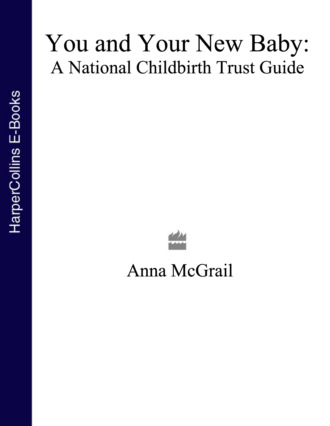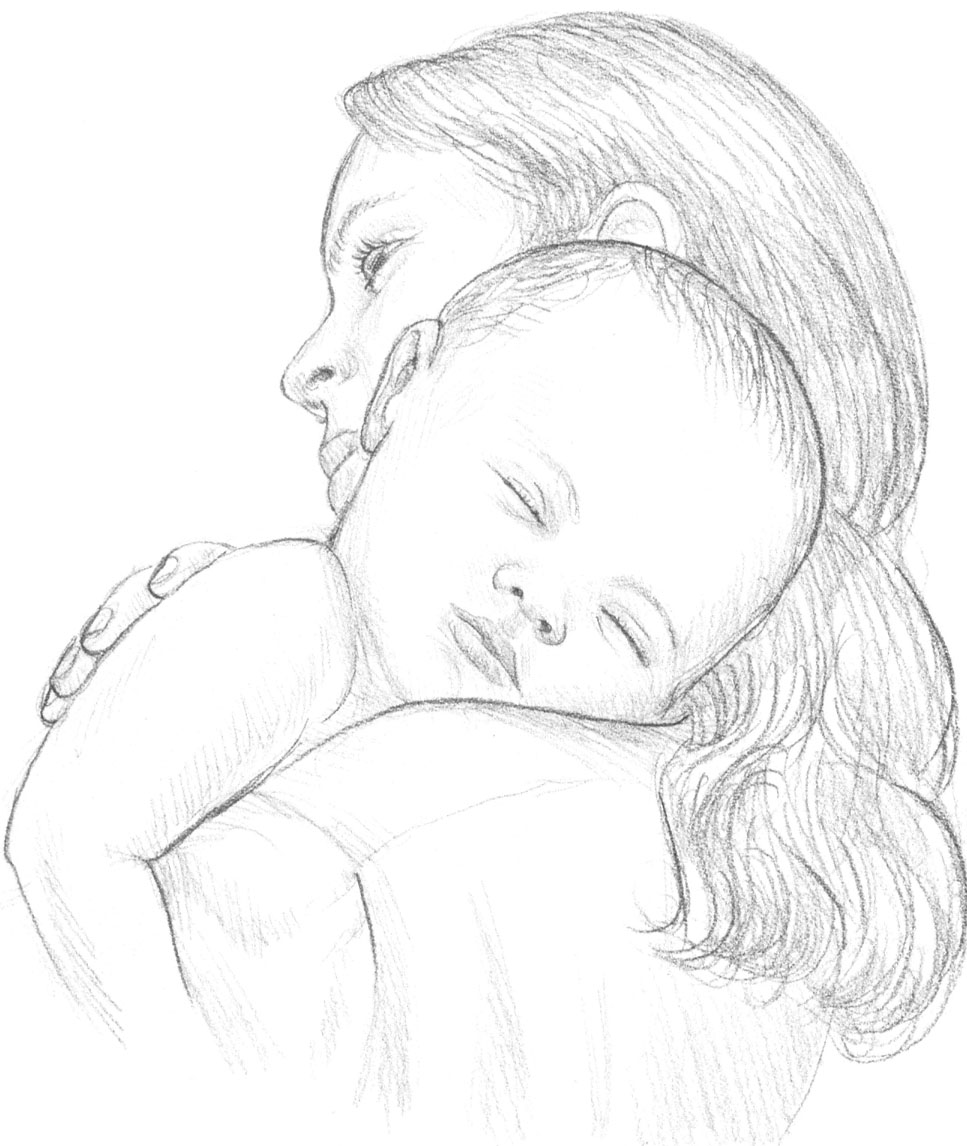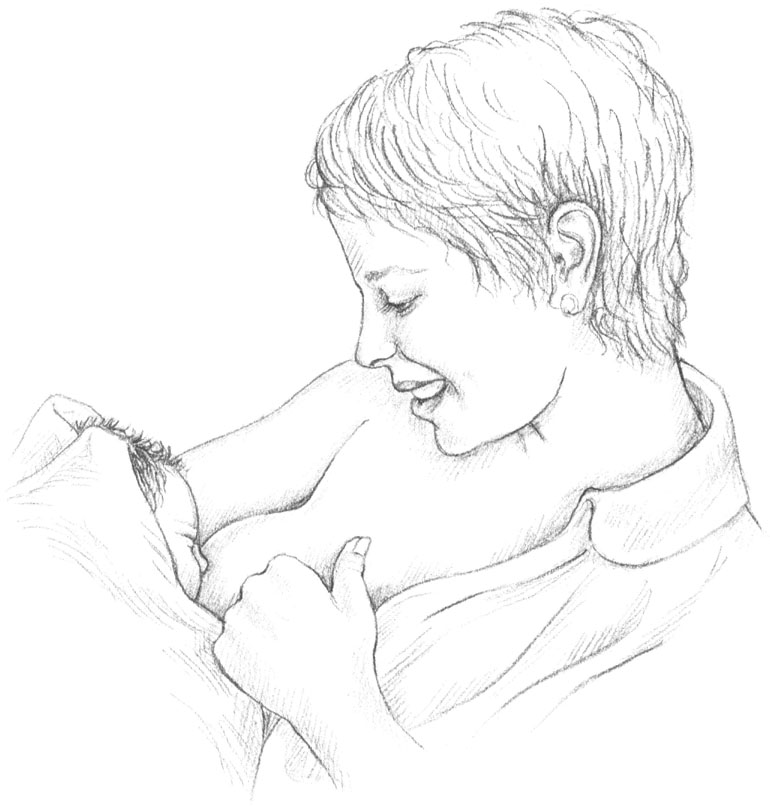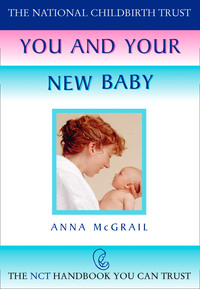
Полная версия
You and Your New Baby

You and Your New Baby
Anna McGrail
A
NATIONAL CHILDBIRTH TRUST
GUIDE
Published by National Childbirth Trust Publishing
in collaboration with Thorsons

Copyright
Production in association with
Book Production Consultants plc,
25–27 High Street, Chesterton, Cambridge CB4 1ND, UK.
Published by National Childbirth Trust Publishing,
25–27 High Street, Chesterton, Cambridge CB4 1ND, UK.
in collaboration with Thorsons
An Imprint of HarperCollins Publishers Ltd
1 London Bridge Street, London SE1 9GF
www.harpercollins.co.uk
© 1996 NCT Publishing
First published as Becoming a Family 1996
This edition 1998
A CIP catalogue record for this book is available from the British Library.
Illustrations: Jo Dennis.
The author asserts the moral right to be identified as the author of this work
All rights reserved under International and Pan-American Copyright Conventions. By payment of the required fees, you have been granted the nonexclusive, non-transferable right to access and read the text of this e-book on screen. No part of this text may be reproduced, transmitted, downloaded, decompiled, reverse engineered, or stored in or introduced into any information storage retrieval system, in any form or by any means, whether electronic or mechanical, now known or hereinafter invented, without the express written permission of HarperCollins e-books.
Source ISBN 9780722536377
Ebook Edition © APRIL 2019 ISBN: 9780008359508
Version: 2019-05-13
HarperCollinsPublishers has made every reasonable effort to ensure that any picture content and written content in this ebook has been included or removed in accordance with the contractual and technological constraints in operation at the time of publication.
Note to readers
This ebook contains the following accessibility features which, if supported by your device, can be accessed via your ereader/accessibility settings:
Change of font size and line height
Change of background and font colours
Change of font
Change justification
Text to speech
Page numbers taken from the following print edition: ISBN 9780722536377
Publisher’s note
ALL COMMENTS and personal accounts were given to us in confidence, so out of respect for our contributors’ privacy we have changed all the names.
We have endeavoured where possible to reproduce quotations verbatim, but where editing has been applied, the integrity of the quotation has been maintained.
Dedication
For Benjamin and Christiane.
Contents
COVER
TITLE PAGE
COPYRIGHT
NOTE TO READERS
PUBLISHER’S NOTE
DEDICATION
INTRODUCTION
CHAPTER ONE – YOU AND YOUR NEWBORN
Journey into the unknown
Caesareans
Twins or more
Looks
Vitamin K
First attempts
Your baby’s temperament
The growth of love
When things aren’t as you expected
Transition
A ‘routine’
CHAPTER TWO – LEARNING NEW SKILLS
Holding
Bathing
Changing
Dressing
Sleeping
Feeding
Wind
Weaning
Crying
Teething
Growing
Playing
Nursing
Developmental disabilities
Loving
Smiling
CHAPTER THREE – YOUR NEW SELF
Recovery
Debriefing
Caesareans
Stress and anger
Feeling down
Being yourself
Self-image
Sleep
Nutrition
Exercise
Making time for yourself
CHAPTER FOUR – YOU AND YOUR PARTNER
Expectations
Realities
Role reversal
Time
Time for you as a couple
Changes in your relationship
Sex
Difficulties
Single parents
CHAPTER FIVE – YOU AND THE WORLD
Back home
Getting about
Balancing the budget
Friends
Boredom
Relatives
Experts
CHAPTER SIX – YOU AND THE FUTURE
You are now a parent
Working
Broadening horizons
Picking up where we left off
Protecting your child
Looking forward
CHAPTER SEVEN – BECOMING A FAMILY
Ceremonies
Assisted reproduction
Adopting
Step-parenting
The next child
Being a family
DIRECTORY
A chapter-by-chapter guide to support and information
FURTHER READING
ABOUT THE AUTHOR
OTHER BOOKS BY
ABOUT THE PUBLISHER
THE NATIONAL CHILDBIRTH TRUST (NCT) offers information and support in pregnancy, childbirth and early parenthood. We aim to give every parent the chance to make informed choices. We try to make sure that our services, activities and membership are fully accessible to everyone. Donations to support our work are welcome.
Introduction
THE WORDS of the parents in this book have been drawn from the conversations and interviews I have had with parents over the past six years, eight months and twenty-five days. I can pinpoint this time so accurately as this was the date our son was born. No sooner had he arrived, than I was plunged from the relatively ordered world of singles and partners to the chaos of babies and families.
Being a parent is one of the most difficult and demanding jobs we will ever be asked to undertake. It is also one of the most rewarding. But steering a path between the difficulties to reach the rewards is sometimes harder than we would ever have dreamed possible.
Becoming a family is something most of us undertake as a couple, relying on the strength and support our partner can give. For some, choice and circumstances mean that we take the step alone, or carry most of the responsibility alone.
Nevertheless, whether you are with a partner or a lone parent, the way our society is structured, and the way the world works, means that a great deal of the shock of babies is borne by the mother. Very often the proud father can return to work, accept the congratulations, and get on with business as usual. It is the new mother who needs to negotiate her way around this new world … usually without a map.
That is how it felt to me. In fact, it felt worse. I felt like I was bobbing around on a sea without a lifeboat, and all reference points were gone. And that is why I have spent so much of the past six years, eight months and twenty-five days talking to other parents, finding out if it felt like this for them, too, finding out just what I was meant to do, and how I was meant to do it.
I live in Brighton, but not all the parents whose voices you will hear in this book do: in my role as an editor on the local NCT newsletter, and then for the NCT national journal New Generation, I have met and talked to new families from all over Britain. When I was asked to write this book, I contacted a lot more parents, many of whom have made written contributions to this final manuscript. I have them all to thank. I have them all to thank twice over, because when you are a new family, time is at its most precious.
I’d also like to thank Sue Orchard and Heather Welford who gave their time and expertise and made valuable contributions to the final typescript.
The aim of this book is to let the voices of these mothers and fathers act like beacons for all those currently adrift on the sea of parenthood: whether you are bobbing happily along on the waves and wondering where to go next, or whether you are caught up in darker currents and confusions. Now my daughter is four and safely off to school this September, I feel I have negotiated another major milestone in the path of parenthood, but still, hearing other people tell of what it’s like from their point of view continues to be one of the most valuable ways for me of defining where I want to go, even if it is just a matter of deciding – well, I don’t want to do that.
For all those brave and generous enough to talk to me so openly and generously, thank you. Your names have been changed but you know who you are.
For all those still coming to terms with being a family, this book is for you.
Anna McGrail,
September 1995.


CHAPTER oneYou and your newborn
THE MOMENT of birth may be exactly that: a moment, a joyous, unforgettable moment, or an unpleasant experience we’d rather forget. Becoming a parent, however, can take a bit of getting used to. Even if your pregnancy was planned, the baby’s room is decorated and the cupboards are well stocked, don’t be surprised if life as a parent isn’t what you thought it would be. There is a word for it: ‘babyshock’.
JOURNEY INTO THE UNKNOWN
The first twenty-four hours
WE CANNOT know what parenthood will be like until it happens. Yet many couples find that the first few months are much harder than they expected. After the elation and excitement of the birth, they are tired, stressed and bewildered. Although you are delighted that your baby is here, even those first twenty-four hours can be more difficult than you envisaged.
Katharine found both her baby and the hospital experience overwhelming: ‘It was dreadful. Max wouldn’t settle and I had a catheter in which was uncomfortable, and the room was hot and stifling and the corridor outside was noisy. I was awake most of the night and so shattered the next day I couldn’t take in all the information that people kept popping in to tell me. The room was like Victoria Station. People were in and out and I didn’t know who half of them were: midwives, paediatrician, someone bringing a bunch of flowers from my mum and then other people looking for a vase to put them in …’
COUPLES OFTEN find that with the demands of a new baby it can take a while to calm down, and discover just what it is that you do feel. Lynn found the first few days of motherhood a real eye-opener: ‘Looking back, I was very naive. I hadn’t a clue what new babies were like: the only babies I’d had much to do with before were older, about nine or ten months old, so I was used to seeing them sitting up and playing, smiling…eating biscuits, for Heaven’s sake. Just to have Adam so completely helpless, so dependent on me, was terrifying.’
Olivia kept being surprised by her daughter: ‘I don’t think I had ever pictured her, physically. I don’t think you do. You picture them more as toddlers and what they’re going to look like when they’re people. For instance, I did think that all babies looked the same and I was amazed in hospital how they didn’t. For a start, mine was the most beautiful on the ward, of course! And Robert kept saying, “You know, even objectively, I’m sure she’s the most beautiful. There’s no doubt. And I’m not just saying this because I’m her father.” And I couldn’t convince him that everyone on the ward thought the same about their own baby. So that was nice, really, that she was so lovely’
CAESAREANS
PARENTS WHOSE baby was delivered by caesarean often find that they have particular problems adjusting to the fact of the baby’s arrival. After all, at the last minute, the decisions were taken out of their hands.
Eileen had a long labour and eventually needed an emergency caesarean: ‘After what seemed like hours they finally wheeled me in to the operating theatre and the anaesthetist said, “You ‘II feel a pressure round your neck now …” and that’s the last thing I can remember before coming round. And when I did come round, neither the baby nor Mick was there, so I thought, “Oh, I haven’t had the baby yet, then,” so when Mick did walk in, I said, “What are you doing here?” Mick said they’d taken the baby up to the Unit as he wasn’t breathing properly, and I said he should be with the baby, so he went, and then the nurse came in when I was awake a bit more and said, “What are you going to call him then?” and I got terrified because I thought it meant that we were going to have to baptise the baby straight away because he was so ill with his breathing and going to die. So I wailed, “Oh, call him Michael after his father.” She looked at me very oddly because I think they just wanted to know what to write on his cot tag up in the Unit.’

Sometimes a caesarean can lessen the feeling of continuity, as it did for Sushma: ‘They brought him in about five o’clock for a feed. He was all washed then and wrapped in a white blanket, very clean, and so calm – big, dark eyes looking round. I felt like I was being introduced to a stranger, though, who had just dropped in. I was very glad to meet him and all of that, but I didn’t get the feeling that this was the little being I had laboured for so many hours to produce. I felt no connection between this baby in a blanket and the pregnancy I’d had. This baby was here, and I wasn’t pregnant any more, but they didn’t seem to coincide, somehow.’
WHEN YOU’RE preparing for the birth, it may be a good idea to read up about caesareans. That way, if things do turn out not quite the way you planned during your labour, you will be better informed to make choices about the sort of caesarean birth you want.
TWINS OR MORE
ONE IN EVERY 90 births in this country is of twins, triplets or more. If this is your situation, you may find many of the problems of adjusting to life as a family doubled (or tripled). In particular, the physical demands can be exhausting, as Dawn and her husband found out: ‘Sometimes we do despair. The sheer volume of work – washing, drying, bottles, nappies – and the effort involved in lifting three of them into the bath, out of the bath, into the highchair, out of the highchair, into the cot, out of the cot … And the noise! Just when you’ve got the last one off, the other two wake up and start shouting.’
STATISTICS SHOW that unfortunately twins, triplets and other higher order births experience medical problems more frequently in the early months of life, and spend more time in special care.
Colin, whose twins did need special care, used to envy parents who only had one: ‘I just seemed to lurch from worry to worry and they had so much more time. So it was useful to be reminded occasionally just how special the twins were. Although I envied parents who only had one, I would never have swapped the twins for just one, or had them one at a time.’
MOST OF US, when we envisage ourselves with a child, envisage exactly that: a one-to-one relationship. Right from the start, therefore, if you’ve given birth to twins, you have to adjust the dream to the reality in a fairly major way.
Jess felt she was giving neither of her children the attention they deserved: ‘Other parents might have time to show their babies a book, or take them for walks, but I hardly had time to smile at them. If one was being quiet, I’d rejoice, because it meant that I could change the other one’s nappy in peace. Most of the time, though, in those first few months, I felt as if I was listening to a constant grizzle, because – except when it came to feeding – whatever I was giving one, it meant I wasn’t giving it to the other.’
PARENTING IN the way or to the standard you’d imagined may not be possible with twins or more, and individual attention may be at a premium, but twins have each other for companionship and, as they grow older, a guaranteed play partner, in ways that singletons can never know.

Widening the circle can be more difficult, however: the efforts involved in getting out and socialising are multiplied more than seems fair when you have more than one. With her triplets, Dawn found it especially complicated: ‘Sometimes it can seem like too much trouble to put on three pairs of shoes and three coats just so you can wheel them all to the corner shop. But I know from experience that if I don’t go, and if I allow Peter to bring things back from work with him at the end of the day, like milk or a loaf of bread, then I might have no reason to go out, and if I don’t have a reason, I won’t go, and if I don’t go, I’ll just stay in and get more and more miserable. So it’s worth the effort.’
HOWEVER, most parents of twins (or triplets) will confirm the old cliché: that even if the demands and problems are doubled (or tripled) so are the joys and delights.
NEWBORN NICETIES
Some of the physical features of newborns that may cause surprise or anxiety include:
Birth marks (if it’s going to be a mark that’s permanent, someone should come to talk to you about it)
Heads that are moulded (from labour) so that they look squashed; the bones will return to normal within days
Spots (usually entirely harmless, however disappointing)
Hair (either too much or too little, depending on what the parents had thought the baby would have, but any amount is normal)
The sex organs – those on some little boys can appear out of proportion (he will grow into them), those on some little girls may be red and swollen as a reaction to the hormones in her mother’s body. Swollen breasts and even occasionally small amounts of milk are caused by the mothers’ hormones. Breast size will reduce and milk disappear over the first few days
A squint (which often disappears as the baby learns to focus her eyes).
LOOKS
HOW MANY of us new parents were prepared for the black umbilical stump? For the blotchy skin which newborns are prone to? For the way our newborn’s hands and feet can turn blue after a long nap, a sign that the circulation is not yet efficient or mature? In fact, in many respects the picturebook baby you were expecting may bear no resemblance to the child you’ve actually got, as Lynn discovered: ‘It was only when I changed Adam’s nappy for the first time that I got a good look at the umbilical cord … which was definitely something I hadn’t been prepared for. There was this black thing, with a clip on it. What was I supposed to do? The nurse had said “Oh, sprinkle on some of this powder when you clean him”, so I stood there with this talcum powder tin trying to guess if I should move the stump to one side, or lift it up, or just sprinkle all around it. I hadn’t a clue. I was petrified of hurting him. I was convinced that whatever I did, it would be wrong: the clamp would come off, it would bleed, I’d knock it off and do him dreadful damage. Then Adam did a wee all over me and I stopped worrying about the cord and started worrying about that instead.’
THERE ARE MANY kinds of marks on your baby’s body that may worry you, although most need no worrying about whatsoever. There are two kinds of birthmarks: vascular, which are to do with the blood vessels, and pigmented, which are to do with skin colouration. Philippa’s daughter, Sophie, was born with a birthmark: ‘Sophie was born with a red mark on her forehead and at first we never gave it a second thought. The midwives said it was probably a pressure mark from the birth and we were quite happy with that explanation – and relieved. At the six- week check, the doctor was more specific: “It’s a strawberry birthmark – my daughter had one. Don’t worry – it’ll go away on its own. “We were due to go back when Sophie was six months old, but we went back long before then as the mark began to get darker and to swell and we were worried it was some sort of tumour. We saw a skin specialist in London when she was three months old. She started on steroids and almost immediately the mark stopped growing. We were lucky, they think there won’t be a permanent mark, but those first months of her life were dreadful. There was all that uncertainty, all that fear for the future, and all that guilt. Even though this wasn’t a life-threatening condition, and it didn’t mean she had any permanent disability, that mark takes away the enjoyment and all the joy of her arrival even now. I look back at photographs of her when she was newly born and I think: “I should be thinking what a beautiful baby she was”, but I’m not. I’m thinking: “Look at that red mark. Little did we know.”’
BIRTHMARKS
A brown mark – these are present in about ten per cent of babies: sometimes dark brown, sometimes a pale, milky coffee colour. Harmless. May not fade but no treatment necessary.
Mole – a very few babies are born with a mole; raised, flat, dark or light, of any shape. They are only a cause for concern if they suddenly get larger, itch or bleed. If this happens, see your GP.
Mongolian blue spot – a large, blue-grey or brown mark which occurs reasonably frequently in dark-skinned babies, usually on their back or bottom. Harmless. Soon fades.
Port wine stain – a flat, purple-red birthmark caused by blood vessels under the skin; usually harmless but can be distressing for parents, and permanent without treatment. Nowadays, laser treatment can remove these birthmarks safely and effectively in four or five treatments, which can usually be started almost immediately.
Stork bites – small pink blotches, usually near the eyelid. Harmless. Will fade. No treatment required.
Strawberry birthmarks – raised, red marks. Usually occur on the face or neck. They eventually stop growing – although they may initially get larger before they shrink again – and usually fade completely during childhood. May need treatment if it is near your baby’s eyes, or in an awkward place where it could cause her discomfort. In these cases, the mark can be removed with laser therapy.
Tiny brown marks – usually round… stop panicking – it’s a freckle.
DURING THE first 24 hours after the birth, a paediatrician will visit you to check over your baby. The paediatrician will check things like:
Your baby’s hips – to make sure they are fitting nicely in their socket and have not been slightly dislocated by the birth



